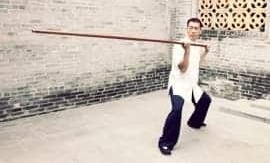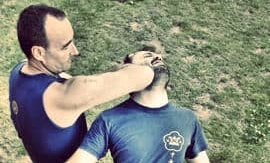
Sifu Michael Mehle was born in 1971 in Germany and began his martial arts journey at the age of seven with Judo, and later trained in Western boxing, Muay Thai Boran and Hapkido.
Working as a doorkeeper at a discotheque and training as a bodyguard, Sifu Mehle gained practical experience in street fighting. In the early 1990s, he fell in love with Wing Chun and has been teaching Gary Lam Wing Chun since 2011.
The basics are the most important thing, which needs to be developed from the beginning and requires continuous development. The guiding principle here is: “From coarse to fine, from big to small.”
Essential attributes are:
Structure: Gives us a good and stable stance, so we can keep our balance and act efficiently.
Timing: Is necessary to do the right thing at the right time.
My Sifu says:
1. The right thing at the right time = perfect;
2. The right thing at the wrong time = unlucky;
3. The wrong thing at the right time = lucky;
4. The wrong thing at the wrong time = stupid.
Speed: Allows us to cause confusion and surprise.
Rhythm is necessary to adapt, to break the beat, cause confusion, and bring our opponent off balance.
Cooperation of limbs and joints is necessary to initiate transitions and changes, to adapt to each situation immediately, and to apply follow-up actions (back-ups).
Internal Power creates explosive energy, enabling perilous attacks. The Long Pole is an excellent tool to create and build up this energy.
Self-Confidence: Without it, any realistic fight will end in defeat. There’s no room for doubt, and when you ask yourself whether the things you’ve learned will work, you will lose. Stop such thoughts. A proper mindset and posture are fundamental requirements for a serious fight or self-defence situation. Otherwise, I would recommend leaving quickly and maintaining a significant distance. Here, a fight you avoided is a fight you won.
Without structure, things will not work correctly, whether in Wing Chun or any other martial art. A good structure will give you a solid stance and a significant advantage in balance. This means focussed motions safely, quick adaptability, and good confidence.
Structure means harmony of above and below (Yin & Yang), which provides the only possibility to draw the necessary power and redirect it into the ground. Structure is also required to explosively release your “bent bow”, through your foot, leg, arm, or hand. Imagine an archer or pistol shooter who doesn’t have proper structure, meaning body tension; their accuracy rate would be miserable.
The same holds true for Wing Chun or any other martial art or sports. If you lack a strong structure, you can’t achieve a good and functional result.
Control of your breath (Qigong) combined with structure and synchronised motions will yield great results in timing, rhythm, speed and cooperation. All this is accompanied by control and feeling.
Focus and immediate solution to the problem. Directly to the point! The Wing Chun system is direct and has a logical structure, without fanciful motions.
The essential point is to take your opponent’s position. We must use mathematics in geometry (structure), and physics (to use and divert forces). As soon as we have established contact, your body takes control, while visual aspects become of secondary importance. What’s now needed is feeling and quick adaption to the situation and motion.
Chi Sau, the soul of Wing Chun, is a special and unique method to learn, train, and practice. It’s like playing chess at top speed. The essential aspects are not visible, however. Feeling and sensitivity are the decisive factors. Follow the motion—placing energetic attacks in the gaps is an excellent way to achieve success.
Control and the proper mental attitude! They are the most important things to focus on. Believe in yourself and control yourself and your opponent. Not having control means to gamble. This is perilous. Your winning chance decreases significantly without control. It increases when you get and maintain control.
Without control, you will quickly lose your balance. Without balance, you can’t defend yourself and fight. A positive mental attitude is necessary to prevail on the street or in a fight without rules. Also, control your feelings well, so you are not dominated by fear or other feelings in a fight.
The timing of inflowing adrenaline should also be considered, so you don’t get paralysed. This would be fatal. Once you decide on either “fight-or-flight”, you must follow this path consistently, directly and quickly, with all the energy you have. One thing I can tell you from experience—the first hit counts!
My actual journey started after I had left one of the biggest Wing Chun organisations, where I was a member for more than a decade. I felt drawn to Hong Kong, where I also practised with Sifu Ip Ching. The Wong Shun Leung lineage was recommended several times, and this is where I finally found what I was looking for.
After a long search, I got to know and appreciate my Sifu, Gary Lam, in 2011. He’s a lovable person with a big heart and vast knowledge, combined with much practical experience regarding fighting and life. This was one of the most memorable moments in my career as a Wing Chun teacher and student, which I will always be, as learning only ends when you stop practising.
After so many years, I finally found my Wing Chun family. No other system and master convinced me, as did Sifu Gary Lam. I’m so thrilled and thankful that our paths crossed and that we have such a cordial relationship. This can’t be taken for granted. The Wing Chun family in Los Angeles, too, is a great group; they are loving and very helpful. Thank you for everything!
I got more relaxed over time, and my unrest settled, which resulted from my rushing through the curriculum and my desire to achieve quick progress. Strength lies in calmness! And it’s impossible to force things. What’s essential is continuous repetition and deepening your foundation. I took a while to understand that the first form is the most advanced. As Confucius says, “If you’re in a hurry, go slowly.” This gives us more time in an accelerated world and allows as to achieve relaxed advancements.
The most important things are continuity and focus. If Wing Chun is the destination, then we have reached it if we practise. If we stop practising, we lose our destination.
Tradition and forms should remain as they were original. It isn’t possible to change the core, the principles, and ideas of the system, together with the traditions in the Kuen Kuit, show us the right path. However, we could develop new training methods, apply elements of other systems such as Yoga or Qigong, and integrate them to achieve better progress to keep our bodies and minds healthy and fit.
The roots and origins of the oldest martial art Kalaripayattu can also be found in Wing Chun. The stance is based on the one used in Kalaripayattu, which is much older. Certain types of Yoga massages and breath control also belong to martial arts. It’s a beautiful compliment, forming an integrated whole. Every teacher and practitioner who studies the matter can contribute to the community. I wish for more unity and cohesion. We are all Wing Chun nuts and love what we do. Only together we are strong.



















